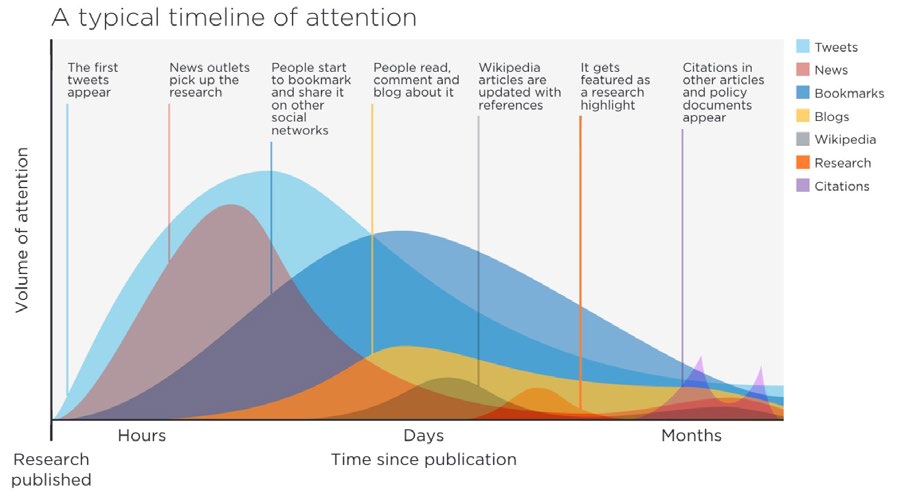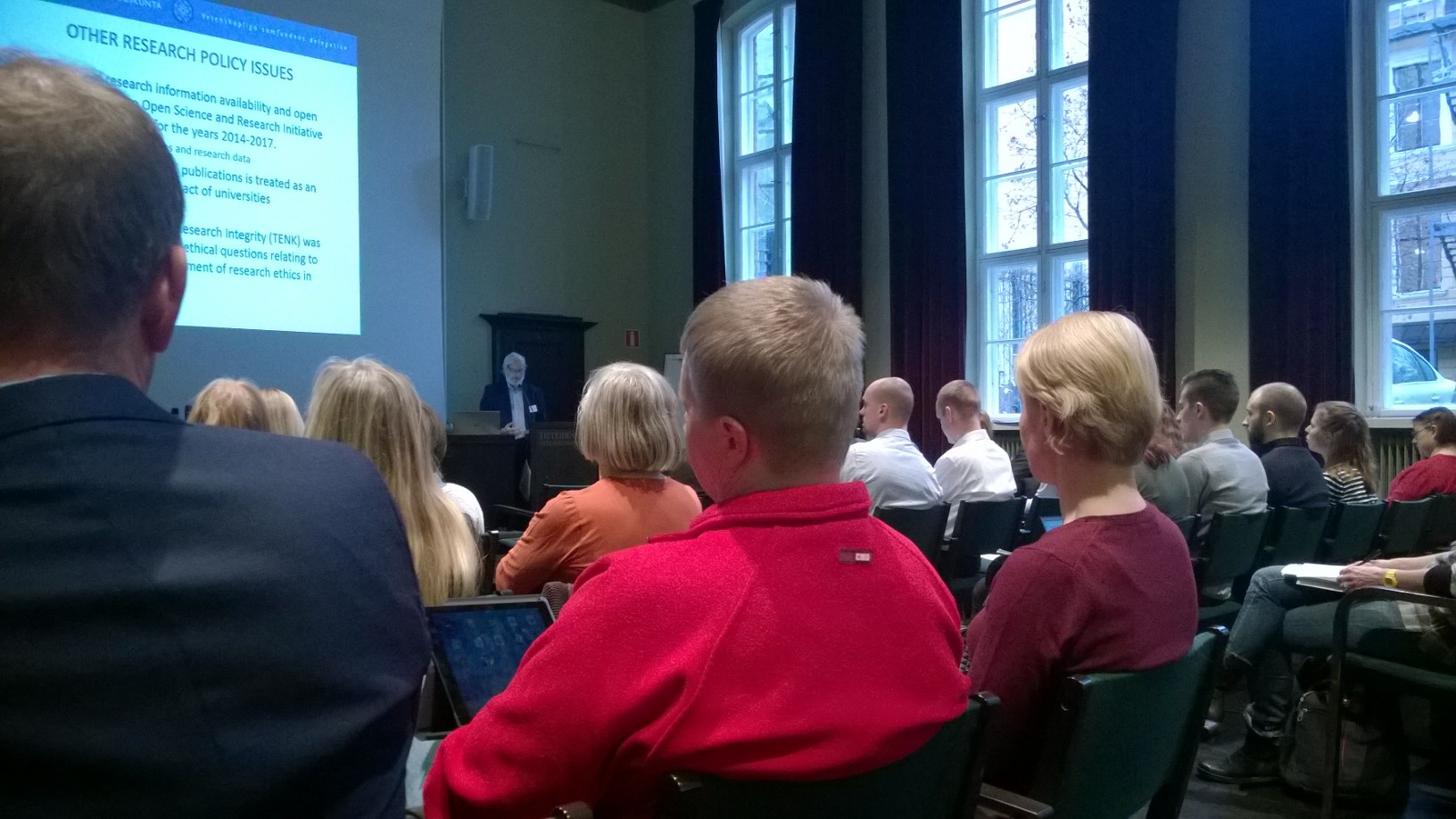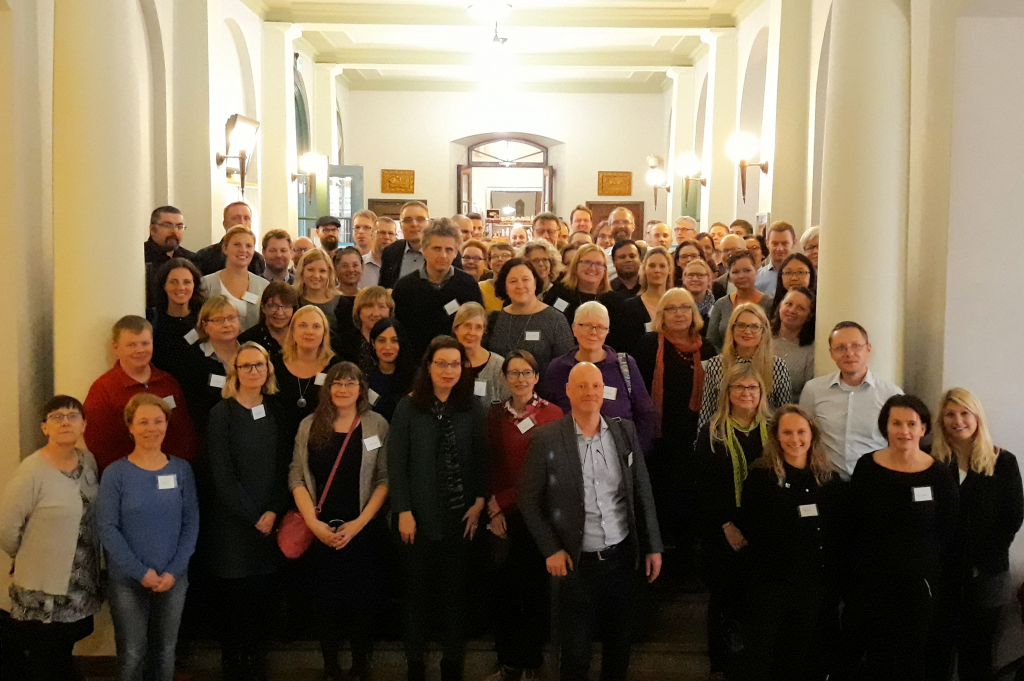NWB 2017 : Pohjoismaisen bibliometriikkaworkshopin parhaat palat | Highlights of the Nordic Workshop on Bibliometrics and Research Policy
(Please, scroll down to read in English.)
Osallistuimme 22:nteen pohjoismaiseen bibliometriikka- ja tutkimuspolitiikkaworkshopiin Tieteiden talossa Helsingissä. Kokosimme tähän ohjelman kohokohdat juuri meille.
Tomin ajatuksia tutkijanäkyvyydestä
Ensimmäinen päivä käynnistyi Kim Holmbergin puheenvuorolla tutkijoiden näkyvyyden mittaamisesta. Puheenvuorossa lähdettiin liikenteeseen tieteellisen viestinnän määritelmästä, jossa huomioitiin sekä muodollinen että epämuodollinen viestintä ja haasteet näiden mittaamiselle. Tieteellisessä viestinnässä yksiköiden määrä on kasvanut runsaasti viime vuosien aikana. Toisaalta tämä mahdollistaa paremmin metriikkojen hyödyntämisen, mutta toisaalta se tuo mukanaan epävarmuuden muun muassa manipuloinnin muodossa. Holmberg korostikin puheenvuorossaan, että altmetriikkaa ei pidä käyttää tutkimuksen arviointiin. Käytännössä altmetriikkaa kannattaisi ehkä hyödyntää vaikuttavuuden mittauksessa, jos käytettävät tiedot ovat riittävän luotettavia. Holmberg viittasikin tähän hyvin, että eri alustoilla tuotettujen altmetriikkojen merkitys ja sovellettavuus ovat edelleen määrittelemättä tai ne ovat muutoin epäselviä. Altmetriikan keinoin voidaan kuvailla vaikuttavuutta eri näkökannoista ja ottaa tarkasteluun erilaisia dimensioita. Tämä antaakin altmetriikan käytölle lisähaasteita, kuinka niitä tulisi lopulta tulkita ja millaisia sovelluksia tai ohjelmia tarvitaan optimaaliseen hyödyntämiseen
Toinen mielenkiinnon kohde päivälle oli Terry Bucknellin puheenvuoro. Aluksi asiaa lähdettiin pohtimaan tekijään liittyvien haasteiden kautta: pohjimmaisena ideana on, että tulisi nähdyksi ja kuulluksi. Tutkija onkin usein ristipaineessa: rahoittaja tahtoo yhtä, työnantaja toista ja lisäksi ovat vielä tutkijan omat intressit. Tutkijalla on mahdollisuuksia kasvattaa näkyvyyttään erilaisin keinoin, hyödyntämällä sosiaalista mediaa, blogeja, Wikipediaa, tviittauksia, uutispostauksia, YouTube-kanavia tai vaikka verkossa toimivia tutkijayhteisöjä. Alla oleva kuva kuvastaa eri tietovirtojen kehittymistä tutkimuksen julkaisemisesta lähtien.

Lähde: http://symplectic.co.uk/guest-blog/research-data-mechanics/
Tutkijalla voisi altmetriikan kautta saada vastauksia kysymyksiin: Kuka on kiinnostunut tutkimuksestani? Miten voisin todistaa tutkimukseni vaikuttavuutta? Miten löytäisin mahdollisia yhteistyökumppaneita? Onko käyttämäni viestintäsuunnitelma tehokas? Mikä on ”kuuma” aihe tutkimusalallani? Missä tulisi julkaista näkyvyytesi maksimoimiseksi? Mitä sosiaalisen median tilejä ja blogeja minun tulisi seurata? Tärkeätä on kuitenkin huomata, että eri välineillä voidaan yhdistellä tietoja ja voidaan laskeskella keskimääräisiä arvoja yksittäisille julkaisuille, mutta luonnollisesti tämähän ei ole tae näkyvyydestä muutoin kuin tilastollisesti, eli edelleen tutkimusaihe ja sisältö vaikuttavat näkyvyyden määrään.
Virpin workshop-ajatuksia
Kun Helsingin yliopiston professori emeritus Ilkka Niiniluoto avasi torstaina 9.11.2017 varsinaisen workshopin, kaksi keskeistä ohjetta osallistujille oli, kysykää ja esittäkää kommentteja esittäjille ja olkaa ystävällisiä kaikille! Näillä ohjeilla workshop sujuikin hyvässä hengessä alusta lähtien.
Torstaipäivältä, ja miksei koko workshopin ajalta, itselleni yksi keskeinen anti oli kuulla esityksiä bibliometriikan käytöstä ja siihen liittyvistä haasteista yhteiskuntatieteellisessä ja humanistisessa tutkimuksessa, joka on minulle hyvin vieras tutkimusalue, koska oma taustani on niin vahvasti terveys- ja lääketieteellisessä tutkimuksessa. Erittäin mielenkiintoinen oli myös Fredrik Piron esitys uusimmasta NORIA-net–raportista, jossa vertaillaan pohjoismaisia yliopistoja ja yliopistosairaaloita bibliometriikan avulla. NORIA-net:n yksi keskeinen periaate on tutkimuslaitosten tutkimusaktiivisuuden ja tutkimuksen vaikuttavuuden vertailu, mutta ei tutkimuslaitosten paremmuusjärjestykseen laittaminen. Lisäksi verkosto pyrkii kehittämään uusia vertailuindikaattoreita. Erityisesti jäi mietityttämään tulos, jonka mukaan suomalaisten tutkimuslaitosten aktiivisuus kliinisessä lääketieteessä ja terveystieteissä on muita pohjoismaita alhaisempi, kun taas esimerkiksi biologiassa, materiaalitieteissä, matematiikassa, tilastotieteissä ja fysiikassa olemme muita pohjoismaita aktiivisempia.
Työhöni tutkimuksen tuen tiimissä sain eniten työvälineitä ja ideoita perjantai päivän posterisessiossa, josta tässä nostan esille erityisesti kaksi posteria. Toinen posteri käsitteli Data-asiain kansalliskomitean Avoin tiede ja tutkimus –hankkeessa (ATT) tuottamia suosituksia tutkimusdataan viittaamisen käytäntöjen kehittämisestä Suomessa. Posteri kuvasi dataviittaustiekartan ensimmäisen luonnoksen, ja sitä oli esittelemässä Data-asiain kansalliskomitean sihteeri Heidi Laine. Juttelin Heidin kanssa ja hän kertoi, että tämän vuoden lopussa valmistuu hankkeen loppuraportti, ja ensi vuoden alusta Heidi jatkaa osittain saman asian tiimoilta uudessa toimenpideohjelmassa. Toista posteria oli esittelemässä Aalto yliopiston johtamisen tukipalveluista tietoasiantuntija Leena Huiku. Hän kertoi minulle, kuinka he tuottavat bibliometrisiä palveluja yliopistolle Tenure Track –hakujen tueksi, jotta Aalto yliopistoon saadaan rekrytoitua kansainvälisiä huippututkijoita. Tämä palvelumalli on ollut nykyisessä muodossaan toiminnassa ymmärtääkseni vuodesta 2015 lähtien, ja kaksi tenure track -paikkaa on tähän mennessä täytetty käyttäen hyväksi tätä palvelua.

Tuulevin pohdiskeluja näkyvyydestä ja vaikuttavuudesta
Nostan perjantailta esille kaksi mieleenjääneintä esitystä, joiden aihepiirit liittyvät tutkimuksen ja tutkijoiden näkyvyyteen ja siihen, onko sillä jotakin tekemistä vaikuttavuuden kanssa.
Arto Lanamäen (Oulun yliopisto) otsikkona oli “Is Any Social Media Publicity Good Publicity? The Case of @RealPeerReview and Altmetrics”. Kysymys on hyvä ja monisyinen. Kyseisen Twitter-tilin tavoitteena on kritisoida ja suorastaan mollata tiettyjen tieteenalojen tutkimusjulkaisuja sarkastisesti ja parodioiden. Sen twiittejä jaetaan ahkerasti, luultavasti myös automatisoiduin keinoin, joten linkitettyjen julkaisujen Altmetric-donitsin lukemat voivat nousta suuriksikin. Myös monet muut altmetriikka-työkalut laskevat twiittejä. Tutkimus saa siis näkyvyyttä sosiaalisessa mediassa eivätkä numerot kerro, onko se positiivista vai negatiivista. Toki Altmetric-donitsia voi klikata nähdäkseen yksityiskohtaisempia tietoja siitä, mikä on vaikuttanut huomioarvoon, sillä nimenomaan huomiosta on kyse. Lanamäen mukaan tutkimuksen vaikuttavuuden mittaamisen takana on vähintään implisiittinen oletus siitä, että kaikki julkisuus on hyvää julkisuutta: Bibliometriikka kohtelee kaikkia viittauksia samanarvoisina, vaikka kaikkia viittauksia ei ole tehty myönteisessä mielessä, ja vastaavasti altmetriikka-indikaattorit eivät kerro vaikuttavuudesta vaan huomiosta tai suosiosta. Jäin pohtimaan, toteutuvatko @RealPeerReview:n tavoitteet tehdä esimerkiksi sukupuolen- tai kulttuuripolitiikantutkimus naurettaviksi nimenomaan lisäämällä niiden huomioarvoa, vai osaavatko alojen tutkijat hyödyntää saamansa julkisuuden, vaikka se tätä kautta näyttäytyykin kielteisenä. Sosiaalisen median maailmassa ei koskaan tiedä.
Hieman toinen tulokulma sosiaaliseen mediaan oli Bergenin yliopiston Susanne Mikkillä and Marta Zygmuntowskalla aiheesta “Citation and social media impact with regard to open publishing” sillä he tutkivat julkaisujen avoimuuden vaikutusta sekä näkyyvyyten sosiaalisessa mediassa että viittausmääriin. He halusivat selvittää muun muassa, miten suuri osa norjalaisista tutkimusartikkeleista on avoimia ja vaikuttaako maininta sosiaalisessa mediassa viittausmääriin? Käyttäen CERES:stä (Nasjonalt senter for felles systemer og tjenester for forskning og studier/National Center for Systems and Services for Research and Studies) saatuja DOI-tunnisteita he tekivät hakuja Google Scholarista ja Altmetric.comista, ja saivat selville, että 70 % kaikista norjalaisista artikkeleista oli avoimia ja että avoin julkaiseminen oli selkeästi etu. Avoimet artikkelit saivat lähes 30 % enemmän mainintoja sosiaalisessa mediassa ja kaksi kertaa enemmän viittauksia kuin maksulliset artikkelit. Heidän johtopäätöksensä on, että avoin julkaiseminen ja verkostoituminen ovat tieteellisen viestinnän tulevaisuus. Myös maailmanlaajuisesti on todettu, että avoin julkaiseminen lisää viittausmääriä merkittävästi. Kiinnostuin tietysti siitä, kuinka suuri osa suomalaisista tieteellisistä julkaisuista on avoimia, mutta samalla tavalla kuin Norjassa sitä ei liene vielä selvitetty. ATT:n mukaan Suomessa vuosien 2008-2011 aikana ilmestyneistä tieteellisistä julkaisuista arvioidaan tällä hetkellä olevan avoimesti saatavilla noin 48 %. Komission asettama Europan Unionin laajuinen tavoite on 60 % julkaisuista avoimena vuoteen 2020 mennessä. Norjassa ovat avoimuusasiat siis aika hyvällä mallilla EU-maihin verrattuna.
Lopuksi: Kannattiko osallistua? Miksi? Menisitkö uudelleen?
- Tomi: Ehdottomasti. Monipuolisia puheenvuoroja metriikan nykytilasta. Tottahan toki, mikäli mahdollista.
- Tuulevi: Ilman muuta kannatti. Näkökulmat biblio- ja muuhun metriikkaan olivat niin monitahoiset, että monenlaisille osallistujille riitti kiinnostavaa kuultavaa. Tottakai, miksei vaikka ensi vuonna Ruotsin Boråsiin.
- Virpi: Yllätyin positiivisesti siitä, että myös ensikertalainen sai paljon irti workshopista. Lähtisin mielelläni myös uudelleen.
Lisätietoja:
Workshopin esitykset tulevat jakoon FigSharessa

We participated in the 22nd Nordic Workshop on Bibliometrics and Research Policy at the House of Science and Lettes in Helsinki. This is a brief summary of our report of the highlights.
Pre-workshop on research visibility
The first day started with Kim Holmberg’s speech on ”Measuring researchers’ online visibility”. He started the presentation with the definition of scientific communication. The definition was wide and acknowledged both the formal and informal communication in the scientific area. Holmberg mentioned some challenges in measuring them. In scientific communication, the number of units has increased significantly over the past few years. On the one hand, this makes it easier to use metrics but on the other hand, you have to remember the possibility of manipulated data. In his speech, Holmberg emphasized that altmetrics shouldn’t be used to evaluate a research. In practice, it would be worthwhile to use altmetrics in measuring the effectiveness if the data used were sufficiently reliable. Holmberg also pointed out that the significance and applicability of the altmetrics produced on different platforms are still unspecified or otherwise unclear. Altmetrics can be used to describe the impact from different perspectives and to consider different dimensions. This brings further challenges to altmetrics: how to interpret the results and what kind of applications or tools are needed.
Another point of interest for the day was the speech by Terry Bucknell. The presentation begun with a reflection on the factors related to the authorship: the basic idea is to be seen and heard. The researcher is often between a rock and a hard place; the funder wants one thing, the employer wants another, and, in addition, there are also the researcher’s own interests. The researcher has the possibility to increase his/her visibility by various means, using social media, blogs, Wikipedia, tweets, news posts, YouTube or even online researcher communities. The picture below shows the typical timeline of attention.

Source: http://symplectic.co.uk/guest-blog/research-data-mechanics/
With the help of altmetrics, the researcher could find answers to the following questions: Who is interested in my research? How can I prove the effectiveness of my research? How can I find potential partners? Is the communication plan I used effective? What is the ”hot topic” in my research field? Where should I publish in order to maximize my visibility? What social media accounts and blogs should I follow? However, it is important to note that with different tools you can combine data and calculate average values for individual publications, but of course, there is no guarantee of visibility, except for statistical purposes. The research topic and content still determine the visibility.
Virpi’s thoughts on the workshop
In his opening words, professor emeritus of University of Helsinki Ilkka Niiniluoto advised us to ask questions and comment after every presentation and be friendly to everybody! With these words, the workshop went in high spirits from beginning to end.
For me, one of the most essential parts of the workshop was to hear presentations on use of bibliometric indicators in social sciences and humanities which are very unfamiliar disciplines for me as my background is more in health sciences and medicine. A very interesting presentation was also Fredrik Piro’s speech on the latest Noria-net report. The purpose of the Noria Network is to compare research activity and research impact of Nordic universities and higher education sectors by bibliometric indicators. In addition, the network develops new indicators. It is noteworthy, however, that the aim is not to rank the higher education institutions. I was a little bit surprised at the finding that the research activity of Finnish higher education sectors is lower in clinical medicine and health sciences and higher in biology, material science, mathematics, statistics and physics compared with other Nordic countries.
I also want to highlight two posters that I found very informative from my standpoint in the research support team in the UEF library. The poster presented by Heidi Laine described the first draft for a data citation roadmap for Finland that has been produced by the Finnish Committee for Research Data executed in the Open Science and Research Initiative. I talked with Heidi, who is a coordinator of the project, and she told me that closing report of the initiative will be ready by the end of this year. At the beginning of the next year, Heidi will continue in another project that will partly concern the same issues. Another poster was presented by Leena Huiku from the Management Information Service at the Aalto University. She told me that since 2015 they have offered bibliometric services to support Tenure Track recruiting processes at Aalto University. The purpose is to get international top researchers to apply open Tenure Track positions at Aalto University and by now two posts have already been filled using this service.

Tuulevi’s contemplations on publicity, visibility and impact
I concentrate here on two presentations from Friday, focusing on research and researcher visibility, and whether it has something to do with impact.
The title of Arto Lanamäki‘s (University of Oulu) presentation was “Is Any Social Media Publicity Good Publicity? The Case of @RealPeerReview and Altmetrics”. The question is good and complex. The purpose of this Twitter account is to criticize and even mock publications in certain disciplines using sarcasm and parody. The tweets are widely distributed, probably also by automation, so the Altmetric donut scores of the linked papers easily rise. Many other altmetrics tools also count tweets. So, these papers get visibility in social media but the numbers do not tell whether it is positive or negative. Of course, the Altmetric badge can be clicked to see more detailed information about what kind of attention has been counted. According to Lanamäki, behind the measurement of research impact there is at least an implicit assumption that all publicity is good publicity: Bibliometrics treat all references equally even though all references are not positive, and altmetrics indicators do not indicate impact, but attention or popularity. I wonder if @RealPeerReview’s aims to ridicule for example gender studies or cultural politics are met when they get more attention, or if the researchers in these fields can turn the visibility to their advantage, even though it is presented as negative. In the world of social networks, you never know.
Slightly another angle to social media was presented by Susanna Mikki University and Marta Zygmuntowska (University of Bergen) in the presentation called “The Citation and Social Media Impact with Open Publishing”. They studied the impact of open publications, their visibility in social media and their citation volumes. They aimed to find out among other things, the open-share of all Norwegian articles, and if there is a citation advantage to articles mentioned on social media. Based on the scholarly output in Norway, using DOIs from CERES, the Current Information System in Norway, and searching Google Scholar and Altmetric.com, they found out that 70% of all Norwegian articles were open and that there was a clear advantage for open publishing. Open articles received almost 30% more mentions on social media and twice as many citations than articles behind the paywall. They concluded that open publishing and social engagement are the future of scholarly communication. It has also been internationally shown that open publishing increases the number of references significantly. Of course, I got interested in the percentage of open publications in Finland, but it has not been investigated in the same way as in Norway. According to ATT, approximately 48% of the scientific publications published in Finland during the 2008-2011 period are estimated to be currently open. The objective of ATT is for Finland to become one of the leading countries in the openness of science and research by the year 2017 and to ensure that the possibilities of open science will be widely utilised in our society. The target of the European Commission is 60% of open publications by the year 2020. In Norway, therefore, they are already more open than in the EU countries.
Finally: Was is worthwhile? Why? Would you attend again?
- Tomi: Absolutely. There were good speeches on current topics on metrics. Of course, if possible.
- Tuulevi: Absolutely. There were many different viewpoints to bibliometrics and other metrics for participants with different interests. Of course, why not next year in Borås, Sweden.
- Virpi: I was positively surprised that also a newcomer made a great deal out of the workshop. I would gladly participate again.
More information:
Workshop proceedings will be available at FigShare
Virpi Lindi, tietoasiantuntija | information specialist
Tuulevi Ovaska, erityistietoasiantuntija | information specialist & communications coordinator
Tomi Rosti, tietoasiantuntija | information specialist
Opetus- ja tietopalvelut | Training and information services